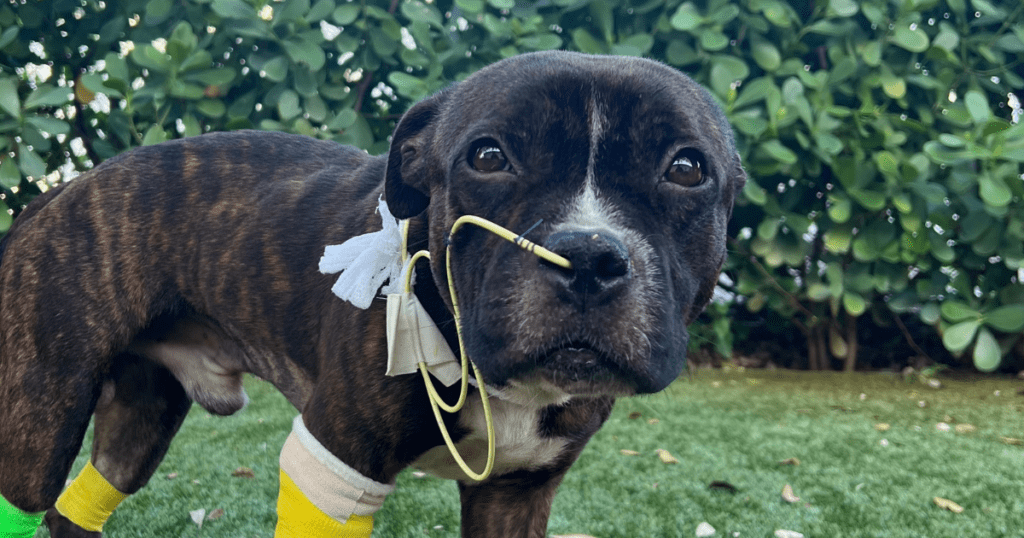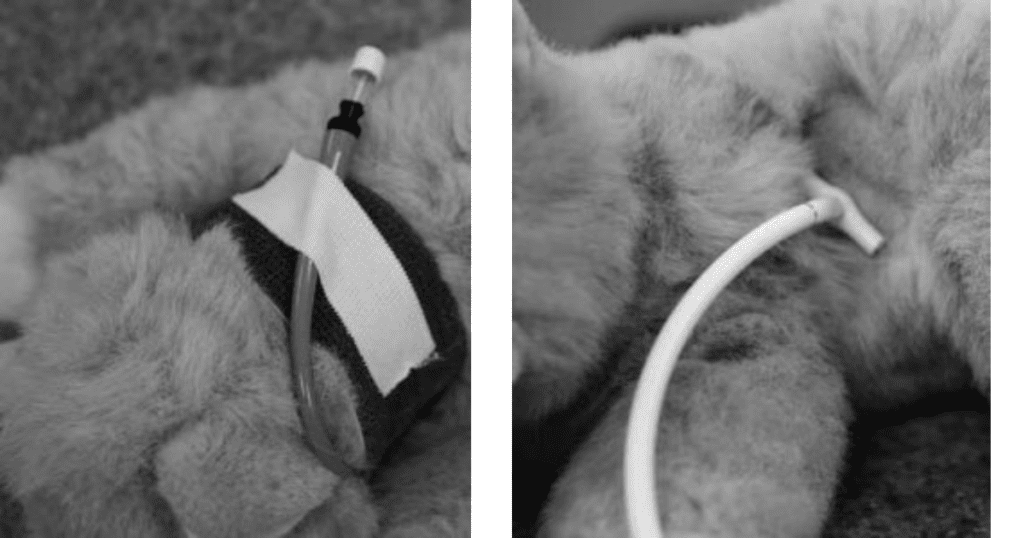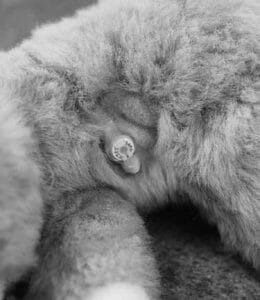Internal Medicine, Critical Care
Feeding Tubes for Short and Long-Term Nutritional Needs in Pets

Adequate nutrition can be an important aspect in the management of any disease process. There is an ever-growing body of evidence that supports the use of nutrition early on in many diseases. Early and appropriate nutrition can hasten recovery, shorten hospitalization, and even decrease the level of pain or discomfort in patients. The fact that in some cases our patients will not eat willingly on their own can present a challenge in the process of managing therapy. Force-feeding is difficult and stressful for patients, technicians, and owners alike. It is very difficult to administer an appropriate level of nutrition this way and can create food aversions as the patient learns to associate this experience with certain types of food.
So What Do We Do When Our Pets Won’t Eat?
Feeding tubes allow us to provide valuable nutritional support to pets that are either unable to unwilling to eat. Some of the more common reasons for feeding tube placement are Anorexia secondary to a chronic disease (chronic kidney disease, chronic pancreatitis); treatment of a critical disease that would benefit from early enteral nutrition (hepatic lipidosis in cats, acute pancreatitis); to bypass a dysfunctional part of the intestinal tract (esophageal disease/dysfunction); aid in hydration in pets that are intolerant of high levels of intravenous or subcutaneous fluids (congestive heart failure, low proteins); aid in the administration of medication in fractious or aggressive patients. There are a variety of feeding tubes that can be placed. Selection depends on the disease process being treated as well as the individual patient’s needs, general health, and likely compliance. There are many types of feeding tubes used in veterinary practice. Some of the more common types are briefly described in the following section.
Feeding Tubes Used in Dogs and Cats
Nasogastric Feeding Tube
A Nasogastric (NG) tube is a small and easily placed tube placed for temporary use. It is placed by passing a small, flexible tube through the nose down the esophagus, and into the stomach. This tube is designed only for short-term nutrition in a hospital setting. There is no incision made when placing this tube, so the recovery time is short and the tube can be utilized soon after placement. Oftentimes, we will place an Elizabethan collar (E-collar) on patients with this type. We can only utilize a specially formulated liquid diet with this type of tube, and cannot administer medications through it.

Example of a nasogastric feeding tube.
Esophagostomy Tube
An Esophagostomy tube (E-tube) is a feeding tube that is placed into the esophagus through a small incision in the left side of the neck. Because of its larger diameter, it can be utilized for a wider variety of diets, including blenderized whole foods. It terminates just before reaching the stomach. It is ideal for longer-term (weeks to months) nutritional supplementation, including in the home setting. Light maintenance to maintain the cleanliness of the tube and site of entry is required to prevent complications. Due to its length, this type of tube is ideal for small and medium-sized breeds.
Percutaneous Endoscopically Assisted Gastrostomy Tube
Most commonly referred to as a PEG tube, this tube is placed directly into the stomach through the body wall with the assistance of a fiber optic endoscope. This tube is more technically demanding to place but is well tolerated and can be used in all sizes of dogs for longer-term nutritional supplementation. Light maintenance to maintain the cleanliness of the tube site of entry is required to prevent complications. A t-shirt or stockinet should be worn by pets with PEG tubes to keep the tube from becoming caught on household objects.

Example of a PEG tube that is placed directly into the stomach through the body wall with the assistance of a fiber optic endoscope.
Gastrostomy Tube
Commonly referred to as a button tube, this tube most commonly replaces a PEG tube after a stoma (permanent opening) has formed in the body wall. This type of tube has a valve that prevents reflux of gastric contents. It is considered to be more cosmetic than a PEG tube, and is used in situations where supplemental food and/or water are thought to be a permanent necessity. Since the tube “hugs” the body, there is a decreased chance of accidental removal.

Example of a gastrostomy tube, or button tube, used after a permanent opening has formed in the body wall.